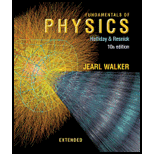
Concept explainers
In a first experiment, a sinusoidal sound wave is sent through a long tube of air. transporting energy at the average rate of Pavg, 1· In a second experiment, two other sound waves, identical to the first one, are to be sent simultaneously through the tube with a phase difference ϕ of either 0, 0.2 wavelength, or 0.5 wavelength between the waves, (a) With only mental calculation, rank those choices of ϕ according to the average rate at which the waves will transport energy, greatest first, (b) For the first choice of ϕ, what is the average rate in terms of Pavg, 1?
To find:
a) The rank of phase difference according to the average rate of transport of energy by the waves, greatest first.
b) The average rate of energy transport for the first choice in (a).
Answer to Problem 1Q
Solution:
a) The rank of phase difference according to the average rate of transport of energy by the waves, greatest first, is ϕ=0 , ϕ=0.2 λ and ϕ=0.5 λ
b) The average rate of energy transport for (a) Pavg=4Pavg1
Explanation of Solution
1) Concept:
The rate of energy transported by a travelling wave depends on the intensity of the wave as well as the area to which the energy is transported. The intensity of a resultant wave depends on the phase difference between the two superposing waves.
2) Formula:
P= I.A
3) Given:
i) The average rate of energy transported by a single wave = Pavg1
ii) The phase difference between the two waves sent through the pipe are ϕ=0 , ϕ=0.2 λ and ϕ=0.5 λ
4) Calculations:
a) The rate of energy transported is given by
P= I.A
I is intensity of the wave and A is area to which the energy is transported.
When two waves are sent with phase difference ϕ1=0 ; the two waves will coincide exactly with each other. There will be constructive interference between the two and the resultant amplitude will be twice the original amplitude. Hence, the intensity of the resultant wave will be 4 times the original. (Since I=(A)2)
Thus, the rate of energy transport for ϕ1=0 will be more than that for a single wave.
When two waves are sent with phase difference ϕ2=0.2 λ ; the two waves will coincide partially. There will be partial constructive interference between the two waves.
Hence, the resultant intensity will be more than the single wave but less than that for ϕ1=0
When two waves are sent with phase difference ϕ3=0.5 λ ; the two waves will show destructive interference. i.e the resultant wave will be a standing wave and not a travelling wave. Hence, it will not transport the energy.
Hence, the ranking of the situations will be
Pφ=0>Pφ=0.2λ>Pφ=0.5 λ
b) Since the amplitude of the resultant wave is twice the single wave, intensity is four fold. Hence, the rate of energy transported will be
Pavg=I .A
∴Pavg=( 4I1).A
∴ Pavg=4 . Pavg 1
Conclusion:
The energy transported by a wave can be calculated by using the intensity of the wave. Here, the intensity changes according to the phase difference between the two superposing waves. Hence the rate of energy transported changes as the phase difference changes.
Want to see more full solutions like this?
Chapter 17 Solutions
Fundamentals of Physics Extended
Additional Science Textbook Solutions
Cosmic Perspective Fundamentals
Microbiology: An Introduction
Biology: Life on Earth (11th Edition)
Microbiology: An Introduction
College Physics: A Strategic Approach (3rd Edition)
Principles of Anatomy and Physiology
- Hi! I need help with these calculations for part i and part k for a physics Diffraction Lab. We used a slit width 0.4 mm to measure our pattern.arrow_forwardExamine the data and % error values in Data Table 3 where the angular displacement of the simple pendulum decreased but the mass of the pendulum bob and the length of the pendulum remained constant. Describe whether or not your data shows that the period of the pendulum depends on the angular displacement of the pendulum bob, to within a reasonable percent error.arrow_forwardIn addition to the anyalysis of the graph, show mathematically that the slope of that line is 2π/√g . Using the slope of your line calculate the value of g and compare it to 9.8.arrow_forward
- An object is placed 24.1 cm to the left of a diverging lens (f = -6.51 cm). A concave mirror (f= 14.8 cm) is placed 30.2 cm to the right of the lens to form an image of the first image formed by the lens. Find the final image distance, measured relative to the mirror. (b) Is the final image real or virtual? (c) Is the final image upright or inverted with respect to the original object?arrow_forwardConcept Simulation 26.4 provides the option of exploring the ray diagram that applies to this problem. The distance between an object and its image formed by a diverging lens is 5.90 cm. The focal length of the lens is -2.60 cm. Find (a) the image distance and (b) the object distance.arrow_forwardPls help ASAParrow_forward
 Principles of Physics: A Calculus-Based TextPhysicsISBN:9781133104261Author:Raymond A. Serway, John W. JewettPublisher:Cengage Learning
Principles of Physics: A Calculus-Based TextPhysicsISBN:9781133104261Author:Raymond A. Serway, John W. JewettPublisher:Cengage Learning University Physics Volume 1PhysicsISBN:9781938168277Author:William Moebs, Samuel J. Ling, Jeff SannyPublisher:OpenStax - Rice University
University Physics Volume 1PhysicsISBN:9781938168277Author:William Moebs, Samuel J. Ling, Jeff SannyPublisher:OpenStax - Rice University Physics for Scientists and Engineers: Foundations...PhysicsISBN:9781133939146Author:Katz, Debora M.Publisher:Cengage Learning
Physics for Scientists and Engineers: Foundations...PhysicsISBN:9781133939146Author:Katz, Debora M.Publisher:Cengage Learning Physics for Scientists and Engineers, Technology ...PhysicsISBN:9781305116399Author:Raymond A. Serway, John W. JewettPublisher:Cengage Learning
Physics for Scientists and Engineers, Technology ...PhysicsISBN:9781305116399Author:Raymond A. Serway, John W. JewettPublisher:Cengage Learning An Introduction to Physical SciencePhysicsISBN:9781305079137Author:James Shipman, Jerry D. Wilson, Charles A. Higgins, Omar TorresPublisher:Cengage Learning
An Introduction to Physical SciencePhysicsISBN:9781305079137Author:James Shipman, Jerry D. Wilson, Charles A. Higgins, Omar TorresPublisher:Cengage Learning College PhysicsPhysicsISBN:9781938168000Author:Paul Peter Urone, Roger HinrichsPublisher:OpenStax College
College PhysicsPhysicsISBN:9781938168000Author:Paul Peter Urone, Roger HinrichsPublisher:OpenStax College





